Honeycomb Cowfish
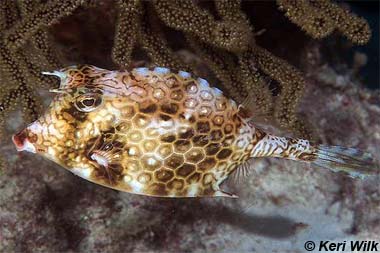
Acanthostracion polygonius
This unusual reef fish has an armor of heavy hexagonal scales covering much of its body, and an elongated caudal peduncle (tail stem) with rounded fins. It has a small, puckered mouth and tiny ‘horns’ over its eyes, with a sloped face and pronounced forehead, giving it its bovine name.
Despite being somewhat rare and shy, this is a popular fish for tourist divers and in public aquariums.
Order – Tetraodontiformes
Family – Ostraciidae
Genus – Acanthostracion
Species – polygonius
Common Names
Common names in the English language are honeycomb cowfish and trunkfish. Other common names include baiacu-de-chifre (Portuguese), botelia (Spanish), coffre polygone (French), cofre (Spanish), peixe-cofre (Portuguese), peixe-vaca (Portuguese), torito (Spanish), torito hexagonal (Spanish), and torito panal (Spanish).
Importance to Humans
This fish is considered an excellent food fish and is often marketed fresh. It is especially prized in the Caribbean region for human consumption where it may be locally abundant. There have also been reports of ciguatera poisoning from eating the flesh of this fish. It is taken primarily in traps and occasionally with seines. This species is also a popular fish for display in public aquarium facilities. It is a relatively uncommon fish and is not easily approached by divers.
Conservation
> Check the status of the honeycomb cowfish at the IUCN website.
The IUCN is a global union of states, governmental agencies, and non-governmental organizations in a partnership that assesses the conservation status of species.
Geographical Distribution
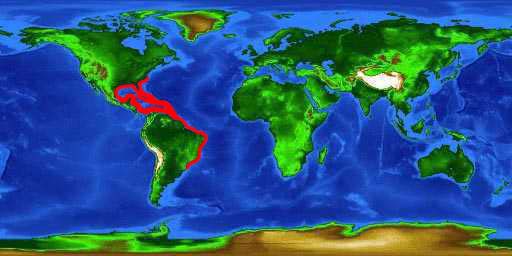
The honeycomb cowfish is distributed in the western Atlantic Ocean from New Jersey (US) and Bermuda, south to Brazil. It is found throughout the Caribbean and Antilles while absent from the Gulf of Mexico.
Habitat
Honeycomb cowfish live in the clear waters of coral reef habitats at depths of 10-262 feet (3-80 m).
Biology
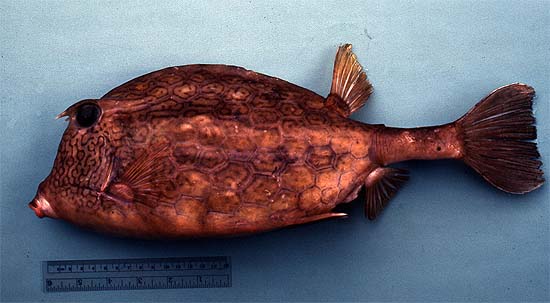
Distinctive Features
The triangular body is nearly enclosed in a “carapace” consisting of thickened hexagonal scale plates that are firmly attached to each other with the exception of the cheeks to allow for respiration movements. There are openings in the carapace for the mouth, eyes, gills, fins, and the flexible caudal peduncle.
There is one pair of scales in front of the eyes. The terminal mouth is small with fleshy lips and the gill openings are short with slits located in front of the bases of the pectoral fins. There are no pelvic fins and the caudal fin is distinctly rounded.
Coloration
The background color of the honeycomb cowfish ranges from gray to bluish and greenish or to yellowish and brown. The carapace of this fish is covered in bold pattern of hexagonal scutes having pale borders surrounding a dark hexagonal ring which in turn surrounds the pale center of the scute.
Toward the dorsal edge of the carapace, these dark hexagons tend to become open and irregular. The dark rings become irregular, forming a reticulate pattern on the cheeks. In larger specimens, the hexagon pattern on the body develops dark stripes within the dark hexagons.
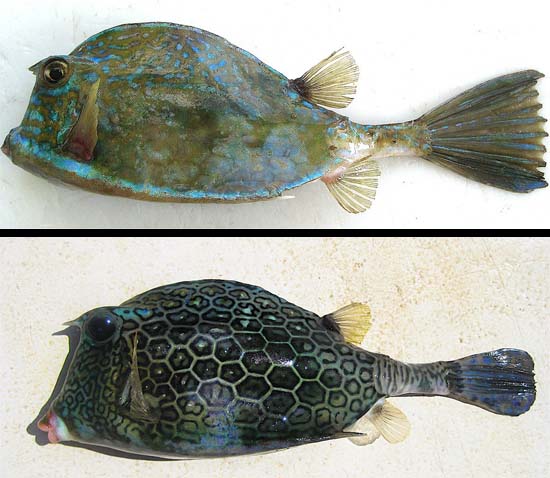
This species may be confused with the closely related scrawled cowfish (A. quadricornis). The body coloration of the scrawled cowfish is more variable, however there are a few distinctions that are constant. There is at least two or usually three dark horizontal stripes on the cheek with the uppermost located just below the eye and the lowermost somewhat above the lower end of the opercular opening.
There is a dark stripe that borders the ventrolateral edge of the carapace from the cheek to the base of the ventrolateral carapace spine and typically a bit beyond. There is another dark stripe located on the dorsal crest of the carapace from the posterior portion of the interorbital region to the anterior edge of the carapace opening for the dorsal fin. Neither of these stripes along the angles of the carapace is present in the honeycomb cowfish.
In addition, the coloration of the rest of the body of the scrawled cowfish includes dark spots, blotches and irregular wavy stripes. These spots tend to be smaller than the diameter of the eye and are located on the lateral surface above the middle eye level, with the blotches and stripes present on the rest of the body. Spots and stripes sometimes extend to the dorsal region of the carapace just posterior to the dorsal fin and on the caudal peduncle and caudal fin. The honeycomb cowfish has similar spots and stripes present on the caudal peduncle but to a lesser degree than the scrawled cowfish.
Dentition
The teeth of the honeycomb cowfish are moderate and conical in shape with usually less than 15 teeth in each jaw.
Size, Age, and Growth
The maximum length of the honeycomb cowfish is 19.7 inches (50.0 cm) total length (TL), although it more commonly reaches lengths of 9.8 inches (25.0 cm) TL.
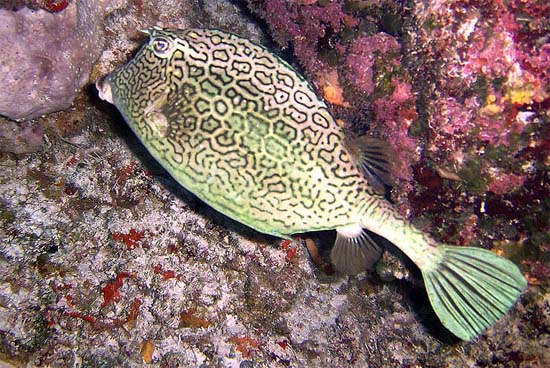
Food Habits
The honeycomb cowfish feeds on marine invertebrates including shrimp, tunicates, and sponges.
Reproduction
Very little is known about reproduction within the family Ostraciidae. However, it has been observed that this species forms social harems consisting of one male along with only two females.
Predators
Larger fish are potential predators of the honeycomb cowfish, however it may be undesirable as a prey item due to its protective external armor, the carapace.
Parasites
Three monogeneans parasites have been reported from the honeycomb cowfish: Haliotrema minutum, H. torridum and H. kritskyi nom. nov.
Taxonomy
The honeycomb cowfish was described as Acanthostracion polygonius by Poey in 1876. Synonyms referring to this species in past scientific literature include Lactophrys polygonia Poey 1876, Lactophrys polygonius Poey 1876, Lactophrys saxatilis Mowbray 1931, and Lactophrys tricornis non Linnaeus 1758. The family Ostraciidae includes the boxfishes, cofferfishes, cowfishes and trunkfishes. The name Ostraciidae is derived from the Greek “ostrakon” meaning shell. There are approximately 10 species within the genus Acanthostracion.
Prepared by: Cathleen Bester